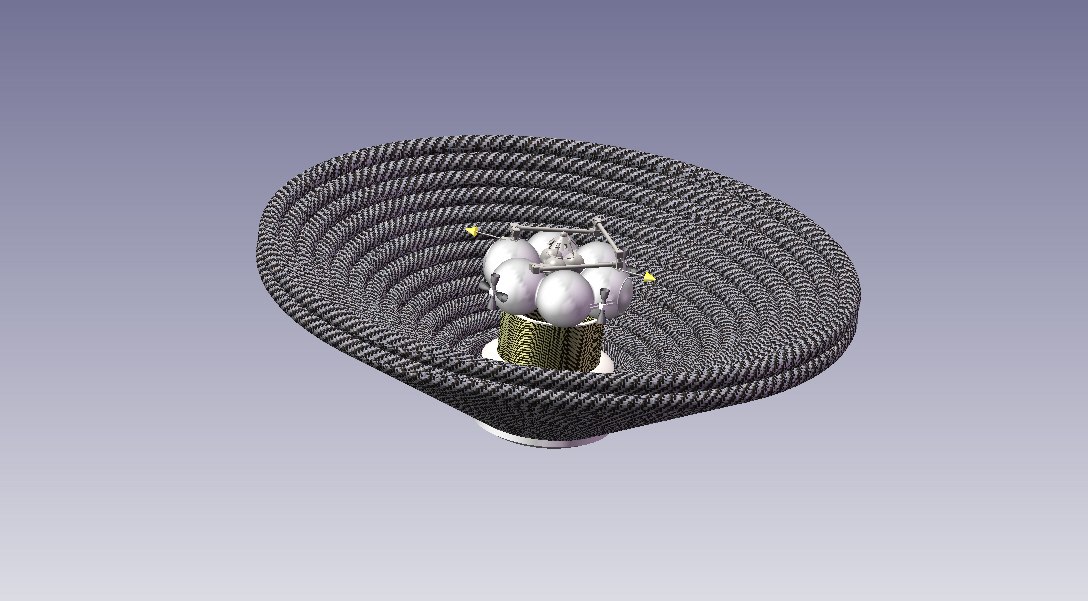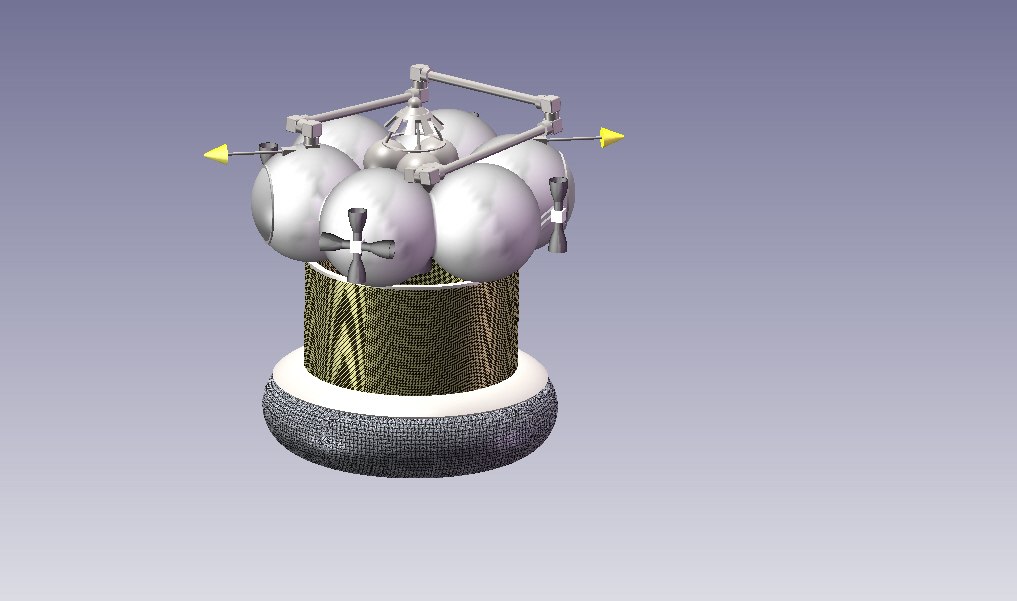Engineer Diploma or How to deliver a piece of Mars to Earth

Foreword
"The State Examination Commission decided to rate" excellent "and assign the title of engineer." So on January 21, I became an engineer with a degree in "Spacecraft and Overclocking Units".
In this article I want to talk about my graduation project "Apparatus for lifting soil from the surface of the planet." The planet was chosen Mars, and the spacecraft was created specifically for this planet.
First, I’ll clarify what the graduation project is, what the student-student is doing and how it all looks.
At the beginning
Work begins with a job. I did not come up with anything of interest, and I had to ask the task of the supervisor. So the topic for the diploma was chosen. So, the task: to fly to Mars; go down to the surface, taking with you the rover; use an inflatable braking device; use a hand manipulator; with a capsule with soil samples fly up into orbit; return to Earth.
It’s unrealistic for one person to master everything in a few months, so some part is taken, for example, for me, the descent to the surface and takeoff. Moreover, all calculations, except for the special part, are taken in the first approximation (i.e., approximately).
')
The composition of the diploma:
1. The general part. In this part, the spacecraft, its systems, alignments, justification, mass reports are described.
2. Special part. Detailed calculation or detailed consideration of any part or detail of the spacecraft.
3. Design part. Calculation of construction or individual parts. Mandatory consultation with the teacher, his signature is required.
4. Ballistics. It is usually not isolated in a separate part, is included in the General. You can consult with the teacher.
5. The technological part.
6. The economic part.
7. Labor protection.
The last three also imply compulsory consultation and signature.
Crowns all the signatures of the signature of the reviewer, after which the authorization for protection is given.
Here is a brief general view.
Diploma
When the tasks are clear, the design begins.
The first thing I started is the layout. The first step was to define constraints.
Inflatable braking device - the development of NPO. S.A.Lavochkina. By analogy with the prototypes (Demonstrator) counted the mass and size of the screen. Stopped on the weight of 1500 kg. Subsequently, the mass increased to 2000 kg: the mass of the entire spacecraft, including the rover and the return vehicle. The diameter of the screen turned out to be approximately 8.5 m. Its central part, which perceives critical thermal loads, is metal.
To determine the size, shape and mass of the return apparatus had to be considered ballistics. At the department gave the program, which considers the rise. The orbit on which the flight module is 400 km - the orbit of an artificial satellite of Mars. To put a 150 kg payload into orbit (that which docks to the flight module and travels to Earth), 1000 kg of fuel is needed. At this stage, it was necessary to increase the total mass of the spacecraft to 2000 kg, and also to limit the mass of the rover to 500 kg (initially it was planned to take the mass, like in Curiosity).
That determined the first framework.
The fuel took a two-component high-boiling. Fuel: asymmetric dimethylhydrazine. Oxidizing agent: nitric tetroxide. Oxygen, and even more so hydrogen did not consider because of their properties to evaporate quickly. A flight is expected to Mars long.
Chose propulsion systems from existing. One sustainer and four engines for orientation. Due to the lack of traction, orientation engines had to be used for lifting too.
Depending on the ratio of fuel / oxidizer counted volumes of fuel tanks. The scheme of the returned apparatus was chosen as in the “Frigate”: 4 tanks with fuel, 2 compartments with equipment. Also added a docking unit, a manipulator, 2 low-directional (non-directional) antennas on the return device. 3 tank boost with nitrogen.
Let me explain: In zero gravity, fuel, like any liquid, is collected in balls and balls. It is impossible to start the engine on fuel in this state. Therefore, invented in the tanks to put an elastic membrane. On the one side of the membrane is pumped fuel, which fills the entire tank. On the other hand, it presses the gas from the pressurized tank, thereby keeping the fuel under constant pressure, and preventing it from collecting into balls. Gas in pressurized tanks under high pressure in many atmospheres.
The returned apparatus is attached through the frame to the transitional compartment in which the rover is to be located. The compartment itself is attached to an inflatable landing gear. In the unfolded state, the inflatable landing gear has the shape of a torus (the shape of the torus is a bagel). Finally, the landing gear is attached to the braking device.
Description of the spacecraft. Drawing on the part of technology.

Here are the schemes:
1. The spacecraft during descent, inflatable braking device is opened.

2. On the surface.

3. Return unit.

The special part is combined with the design. This section took up only at the end. It was necessary to calculate the very cylindrical compartment for the rover made of composite material. But I could not find a more or less understandable method of calculation until I came across an electronic version of the lectures, where there was even an example. The material was taken carbon fiber. Binder - epoxy resin. The shell is obtained by winding the mandrel. Some load values, material properties were taken and the cylinder thickness was calculated taking into account the safety factor.
The safety factor for automatic devices is 1.1 - 1.3. For manned missions 1.5. That is how many times the thickness of materials of different assemblies increases, which were calculated from the conditions of maximum loads.
Next, I took up ballistics. The extra-atmospheric descent section was counted manually from a textbook. The rest of the few programs. On the basis of the data, graphs of overloads, heat loads, distances, and others in the areas of descent and ascent were constructed.
During the descent, the brake screen is reset for a few hundred meters to the surface. At the same time, the landing gear is inflated. In order not to "land" on the discarded screen, the spacecraft makes a small maneuver, flying away to the side.
Inflatable braking device has its own instrument compartment. The returned device is more complex.
On the surface, the device works only from on-board batteries, which are charged directly before uncoupling from the flight module.
Soil collects the rover. After receiving the capsule takes off. During the ascent, after some time, the main engine is reset, since the thrust is needed less. Without an engine, several more extra pounds can be put into orbit. After entering the orbit with the aid of the manipulator, a soft docking with the flight module is carried out. And then a long way back.
On defense there was a question about the descent of the capsule to Earth. Answer. The capsule is fired from the orbit of the Earth in the direction of our country. The capsule has its own heat shield and parachute system. After landing, the beacon starts working, by which we will find it.
By the way, we can bring soil up to 3 kg.
The technological part of all is similar. It examines the manufacturability of the structure, describes the partitioning scheme (see above), selects materials, describes types of joints, assembly scheme. Everyone has their own technological process. In my case, the assembly (welding) of a spherical tank. I also found an existing welding fixture. Simply put, a stationary welding machine. So it was not necessary to develop a device separately. The drawings on it found semi-finished.
According to the technology, as well as the design, the teacher writes a review. These reviews also play a role in the evaluation of the diploma by the commission.
Occupational safety describes harmful factors that affect people. In my case, again, when welding. And describes measures to prevent and reduce these harmful effects. Someone found a small calculation of ventilation. Inserted into this section. The excess was not.
In the economic part, an assessment of the costs of research and development (research work) is carried out, a network schedule with all design works is drawn up. Naturally, the costs are not true. This does not pay attention. Pay attention to the network and all the calculations associated with it.
I will briefly say that the network schedule is a graphic representation of the work, the time spent on these works, what works can be carried out in parallel and at what stages.
That's all. General views and sizes can be estimated from the drawing. It is assumed that the launch vehicle will be the Proton launch vehicle. As a flight module, the Breeze upper stage is conventionally depicted.

At last
Of course, he took something from other diplomas, exchanged something with his classmates. But the work has been done. The theme of the work is also interesting. I wanted to really create something interesting, use all my knowledge. And I think I succeeded.
Now I am an engineer!
Source: https://habr.com/ru/post/210212/
All Articles